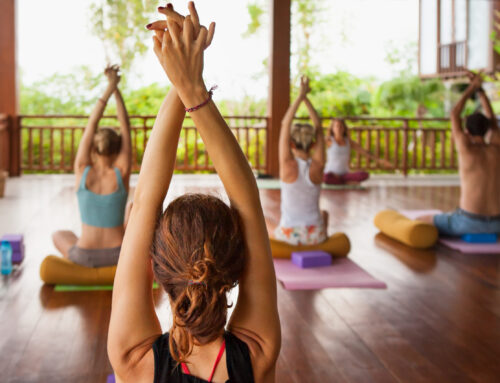There is no doubt that prolonged stress can negatively impact every process in the body, from breathing to creative thinking. Stress can actually keep you from successfully completing the tasks that were causing you difficulty, which in turn cause – yes – more stress. Meditation can reduce this stress and, in turn, help make you a happier, healthier and more productive person.
Types of Meditation
Meditation is a term that encompasses many methods of achieving a more relaxed state. Meditation can incorporate movement or stillness and take place in both areas of little distraction or a traffic jam, once you are more practiced in its techniques.
Most people just beginning meditation opt for a version of guided meditation. This can happen in an actual class or through audio or video instruction. Your guide will suggest a word, situation, color or image that you might find relaxing. Not all images work for all people, but you will find something that you connect with that will allow you to focus your thoughts and energy.
Mindfulness meditation has become a very popular technique, particularly for reducing stress. The goal of this technique is to focus your mind on the present moment. Often, this is achieved by focusing on the flow of your breathing and how your body reacts to it. Mindfulness meditation does not require that you shut down every other thought, only that you don’t judge them. Instead, calmly acknowledge that you have them, while moving back to your present.
Transcendental Meditation® is a mantra meditation in which you repeat to yourself a word, phrase or sound that has been assigned to you for a specific purpose. This process usually begins with a guide, although it can be done privately.
Movement meditations can include Qi Gong, Tai Chi and Yoga. Qi Gong is a holistic approach to health which incorporates meditation, gentle body movements to get the blood flowing and breathing exercises. Tai Chi, when practiced for improved health focuses on awareness exercises, breathing, slow movements and meditation. It can also incorporate elements involving response drills and self-defense skills. Yoga takes on many forms, but the practices include learning physical techniques in order to have greater control over the mind and body connection. There is a belief that through Yoga meditation, you can find elements of upheaval in your mind and body that, once identified, can then be relieved.
Tips for Using Meditation as a Stress Reducer
Anyone can meditate. You don’t need expensive equipment, and you can do it wherever and whenever you have the time. But there are a few things to keep in mind before you begin that might make your process go more smoothly.
No Judgment
It does not matter if you can’t immediately sit quietly in a room repeating a mantra or stay mindful for 60 minutes the first time you do it. Or the 45th time you do it. If you experience one focused minute the first time you try it, that is one minute where you were doing something positive for yourself. Don’t judge your process.
It’s a Reward
Clearly, if you are a busy person, you will have to consciously make an effort to add meditation into your day. Try not to think of it as another thing you need to check off on your “To Do” list. That will just add more stress to your schedule. Instead, think of it as a reward that will have long-lasting, positive impact on your body, mind and soul – even if you can only grab a couple of minutes while you are waiting in traffic.
Maintain Good Posture
If you are beginning your daily meditation in a sitting position, try to maintain good posture throughout your session. If you find yourself hunching over, straighten your posture as you sit. It will allow you to breathe more deeply from your diaphragm muscle and to expand your lungs more fully. It will also take the pressure off of your shoulders and neck muscles as you proceed.
Reset Your Thoughts
If you find your thoughts starting to wander toward next week’s presentation or the grocery shopping you need to do, gently reset. Don’t kick yourself for doing it, just refocus on your breathing. Concentrate on how your body feels. Listen to the sounds of your deep breaths. Focus on your color, image or word.
Quiet Settings
If you find yourself easily distracted or are just beginning your meditation practice, choose a quiet space. The hardest aspect of meditation, be it mindfulness meditation or some other form, is focusing the mind. It’s difficult enough to focus your mind away from the things that happened at work yesterday without also having to battle your cell phone or your e-mail notifications. Once you are more practiced at focusing on your breathing and the present, even time in a dentist’s waiting room can serve as a meditation opportunity.
Be Open
There is no perfect way to meditate. The last thing you want to do is to put so much pressure on yourself that you actually add to your stress. If you need a guide, you have many options that can fit into your hectic schedule. If you would prefer to practice repeating a mantra in a quiet room for 3.5 minutes, great! If Tai Chi feels like the best way to get your mind, body and soul in sync, feel free!
Do Experiment
Don’t be afraid to try different methods of meditation. Not all will work for everyone, and some will work at different phases. Some days you may feel like you want a more guided experience and other times you’d like to practice mindfulness alone. There will be times where you may want to have sacred music playing or incorporate a specific written work. Choose whatever methods help you to reduce your stress and improve your overall outlook. You’ll feel better for it.
Visit Distinctive Collection by Better Homes and Gardens Real Estate® when you begin your journey to buy or sell your unique home.








